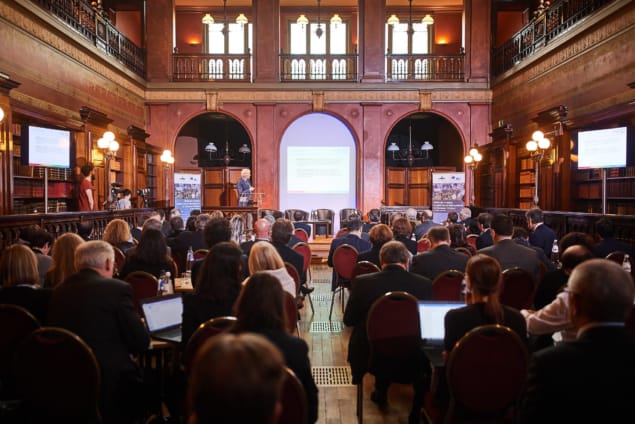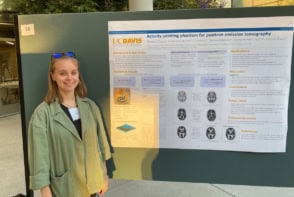The development of nuclear medicine may be one of the most significant technological innovations in healthcare of the past half century, but it is still stubbornly resisted by authorities. This resistance is an almost criminally dereliction of duty towards patient health – at least, according to leading voices at a gathering of molecular imaging experts in Brussels at the end of March.

At a symposium on nuclear medicine organized by the Association of Imaging Producers & Equipment Suppliers (AIPES), doctors, professors and other specialists argued passionately that the latest imaging techniques used to diagnose and treat cancers are already saving lives. The AIPES event was heavy on historic symbolism: it took place at the art nouveau Solvay Library, site of physics conferences for more than a century, attracting the likes of Albert Einstein, Marie Curie, Max Planck, Robert Oppenheimer and Ernest Rutherford.
For Johannes Czernin from the David Geffen School of Medicine at UCLA, the reluctance to embrace nuclear medicine was a moral failure. He lambasted medical authorities who drag their feet on PET imaging, calling it “a healthcare scandal” that it is so underused. “It is time to get angry – not using and not approving PET under many conditions should be considered malpractice,” he said.
He accused authorities of subscribing to “an evidence cult”, setting an impossible burden of proof for new imaging technologies. “But the evidence is absolutely overwhelming,” he said. “Let’s use common sense. It is not worthwhile policing everything, repeating everything country-by-country, and collecting evidence that takes years.”
Slow progress
Although some $1.6 billion has been devoted to the “war on cancer” since it was announced in 1971 by President Richard Nixon, it has not yet been won. “Not much has changed since then. Survival rates are not that different. We don’t detect it early enough,” Czernin said, as he called for complete deregulation of diagnostics. “It’s safe, you can inspect it at any time. If there is a problem, you just shut it down,” he said. “Radiation exposure is nothing – it is essentially homeopathic.”

If the take-up is slow in Europe and the US, Einat Even-Sapir Weizer from the Tel Aviv Sourasky Medical Centre offered a model for rolling out new imaging techniques more quickly. She explained that Israel has led the adoption of novel PET imaging methodologies – such as Ga-PSMA for the early detection of prostate cancer – through a flexible and practical approvals mechanism.
Even-Sapir Weizer described Israel’s basket system for reimbursing the cost of drugs technologies and services, which is regulated by the country’s parliament. Every year the members of parliament decide which licences to give out, which requires them to examine the technology; assess the added value and the expected change in patient management; study the epidemiological data of the disease in Israel; and look at the budgetary impact. As a result, Israel has been quick to introduce technologies like DOTATATE PET-CT and Ga-PSMA, while fluoride is set to be added in the next basket as a tracer.
But even Israel faces barriers to nuclear medicine, Even-Sapir Weizer said. The country needs to build new cyclotrons, draft regulations on tracers, ensure that enough nuclear medicine physicians are trained in imagery. It will also be important to define precise clinical scenarios where the new technologies have a potential impact on patient management and outcome, and to predict the overall impact of any new technology on patients and the healthcare system.
Marcus Hacker, of the Medical University of Vienna, Austria – one of Europe’s leading nuclear cardiology specialists – predicted that the rise of nuclear medicine would not only provide safer and more efficient tumour treatments, but will also help doctors take tricky decisions on which patients to prioritize. Hacker believes that it would enable eventual treatment decisions to be based on more informed criteria.
“These technologies are available and increasingly cheap,” he said, pointing to the “complementary and incremental value” of combining molecular diagnostics and molecular imaging. There is also an evolution in strategies, as medicine enters a personalized approach, Hacker said, with treatments increasingly customized for individual patients. “We used to pour toxic drugs into the body to destroy any proliferating cells. Now we can be very targeted with our drugs,” he said. “Nuclear medicine has a high potential to link target identification with therapy and thus personalize treatment.”
Cost concerns
James Williams, CEO of Siemens Healthcare Molecular Imaging, argued that healthcare authorities often look at costs from a purely financial perspective. “Why do we beat ourselves up on costs? Accountants looking at a spreadsheet may view PET as the nail that sticks out – but that is the wrong way to look at it,” he said. “Ultimately, this is about giving people more time to live better. We can sometimes cure them.”
He said imaging would soon consign methods like deep biopsies to the history books, like “exploratory surgery” a generation ago. “With a combination of in vitro testing and in vivo imaging, will deep biopsy become as rare as exploratory surgery?” he asked. But Williams also warned of an impending resource threat as PET systems rely on “the rarest of the rare earth elements”, lutetium, which is almost entirely controlled by China.
Wim Oyen, professor of nuclear medicine at The Institute of Cancer Research (ICR) in London and the incoming president of the European Association of Nuclear Medicine (EANM), said the imaging community has a duty to reach out to stakeholders in the sector, including regulators and patient groups. “One of our main drivers is patient interest,” he said. “We should stop bickering with regulators, or else it will take way too long for our patients.” Oyen added out that, while nuclear medicine offered brilliant prospects, it still needed to cut its prices. “We need competitive pricing to get ahead. We cannot shoot ourselves in the feet by pricing too high,” he said.



